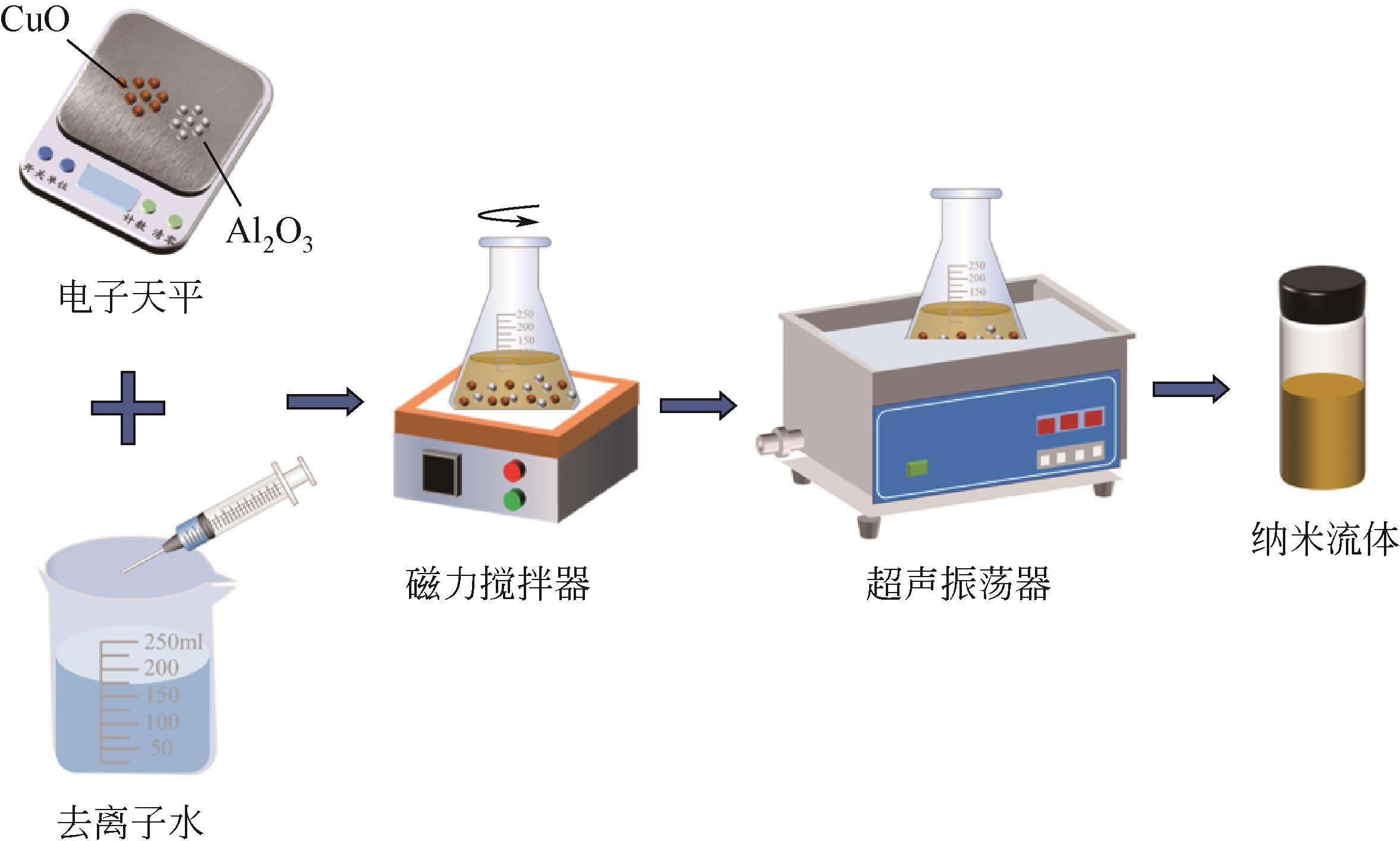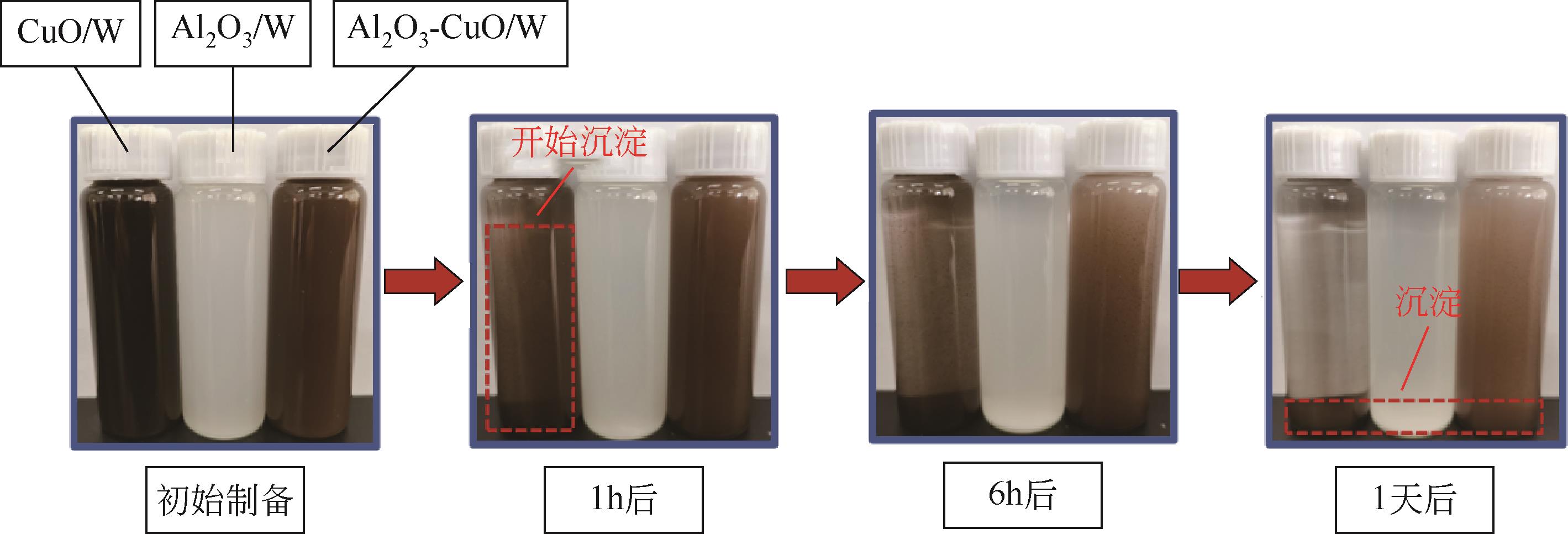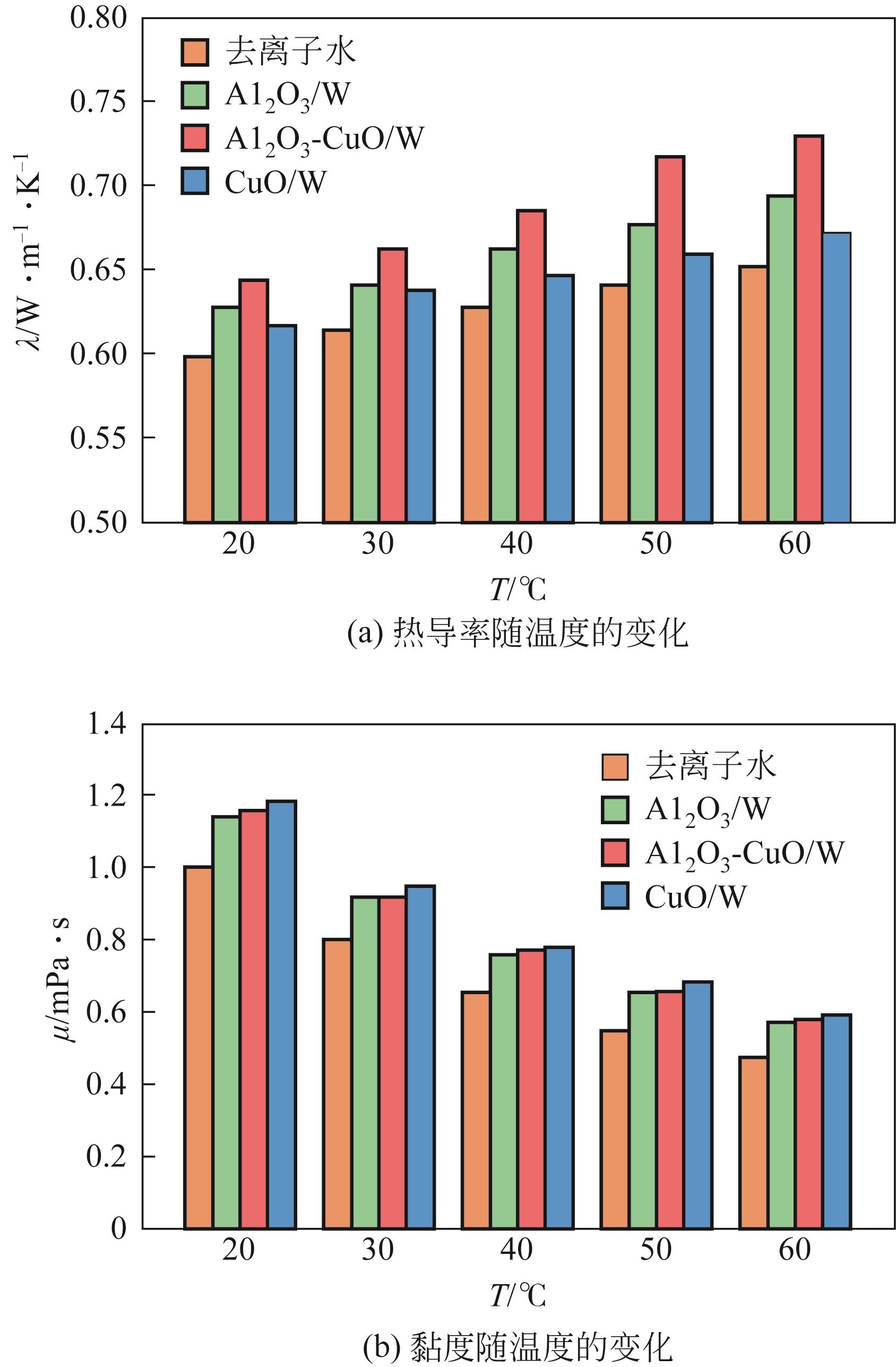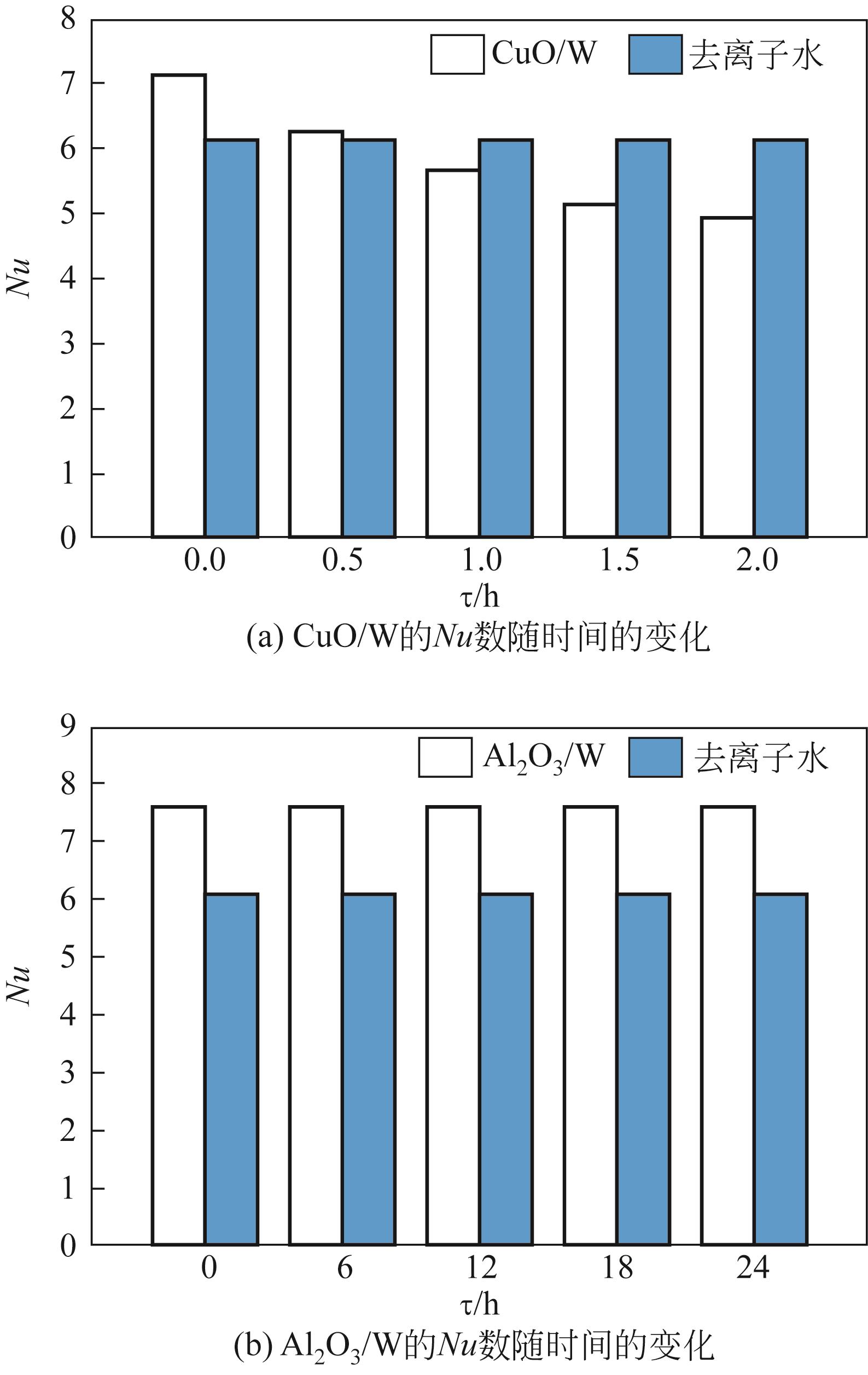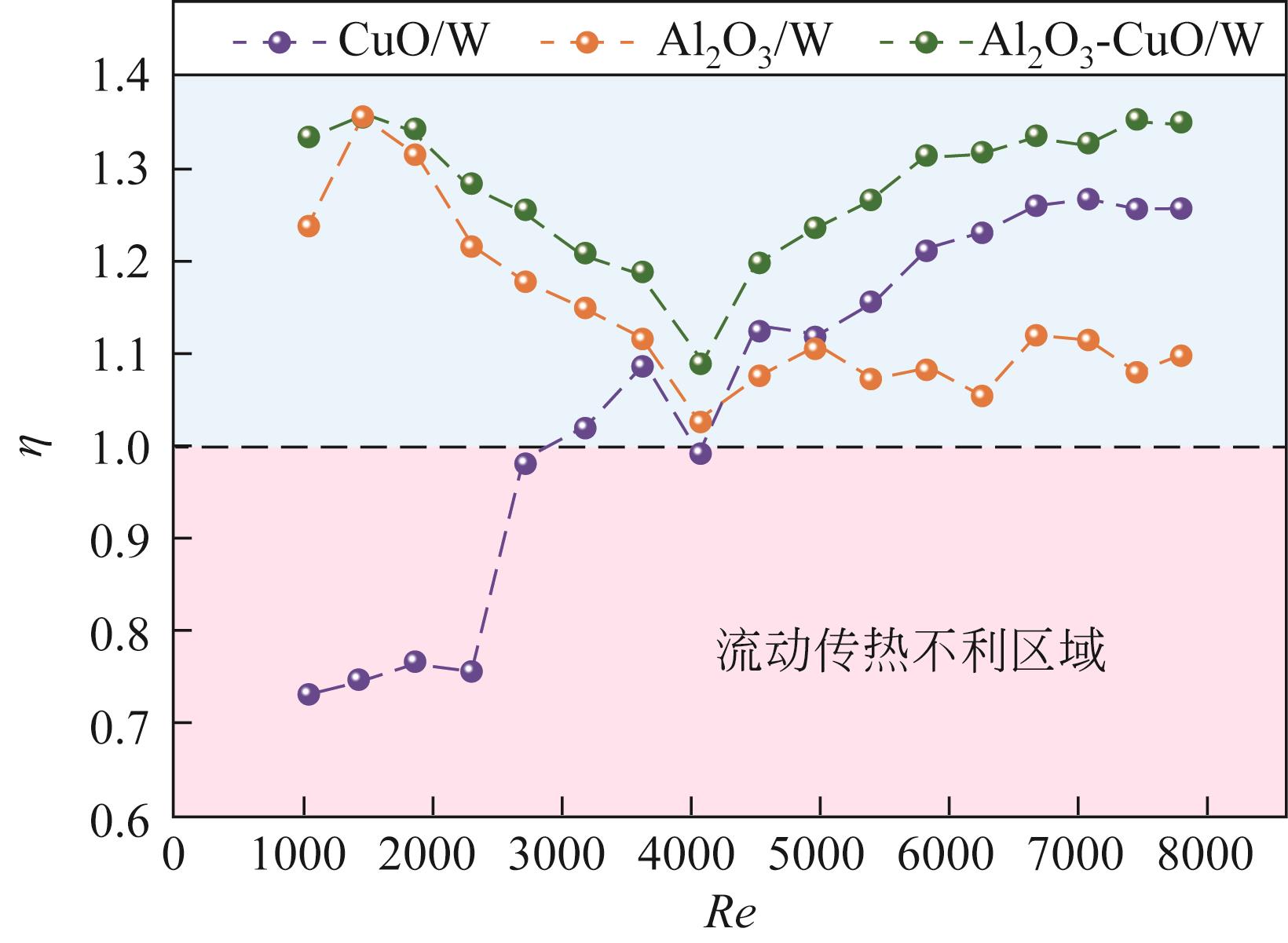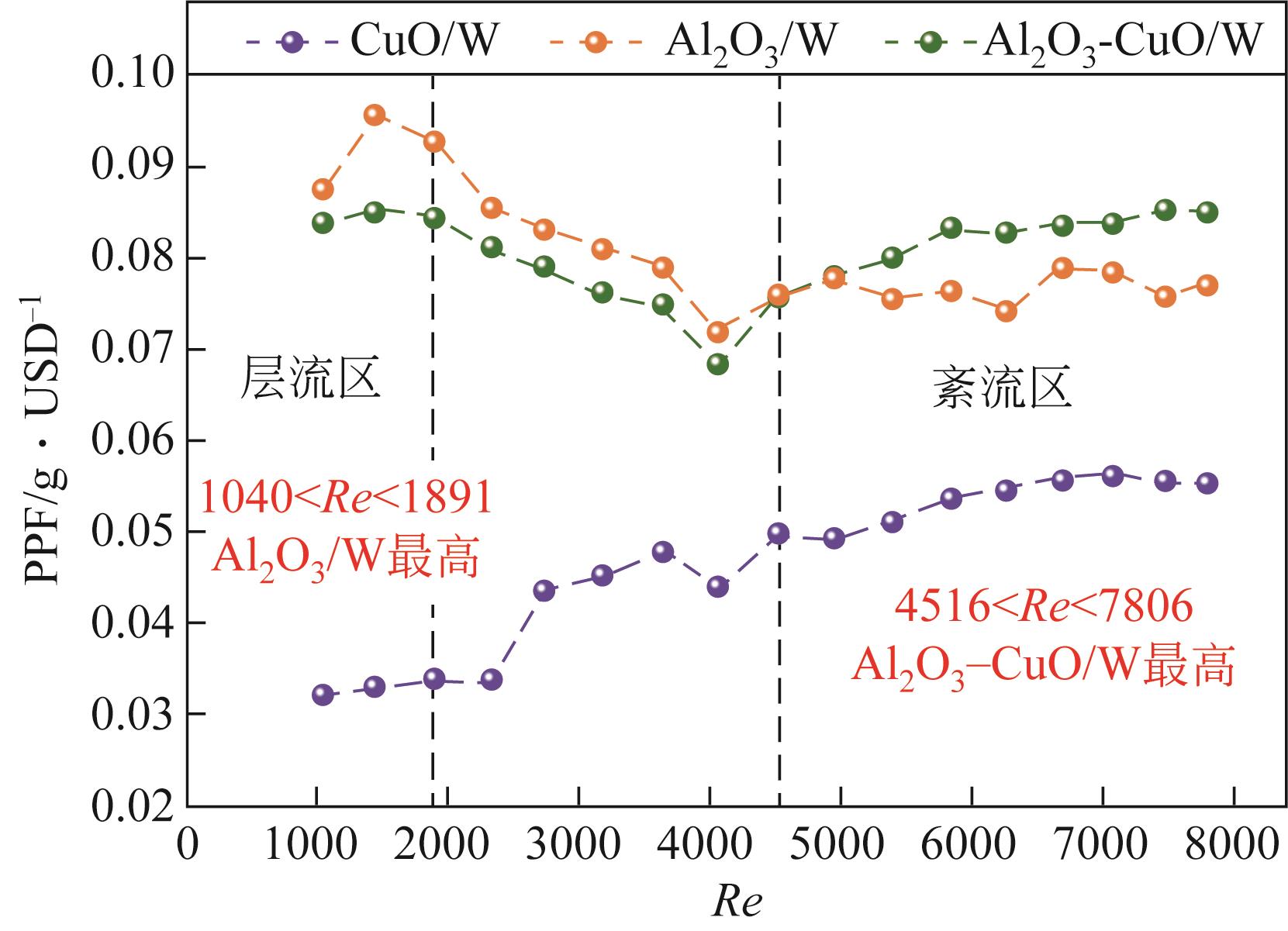Chemical Industry and Engineering Progress ›› 2023, Vol. 42 ›› Issue (5): 2315-2324.DOI: 10.16085/j.issn.1000-6613.2022-1222
• Chemical processes and equipment • Previous Articles Next Articles
Analysis of convective heat transfer and thermo-economic performance of Al2O3-CuO/water hybrid nanofluids
GUO Wenjie( ), ZHAI Yuling(
), ZHAI Yuling( ), CHEN Wenzhe, SHEN Xin, XING Ming
), CHEN Wenzhe, SHEN Xin, XING Ming
- Engineering Research Center of Metallurgical Energy Conversion and Emission Reduction, Ministry of Education, Kunming University of Science and Technology, Kunming 650093, Yunnan, China
-
Received:2022-06-29Revised:2022-08-22Online:2023-06-02Published:2023-05-10 -
Contact:ZHAI Yuling
Al2O3-CuO/水混合纳米流体对流传热性能及热经济性分析
- 昆明理工大学冶金节能减排教育部工程研究中心,云南 昆明 650093
-
通讯作者:翟玉玲 -
作者简介:郭文杰(1996—),男,硕士研究生,研究方向为中低温余热高效利用。E-mail: gwj19961208@126.com。 -
基金资助:国家自然科学基金(52266002);云南省基础研究项目(202001AT070081)
CLC Number:
Cite this article
GUO Wenjie, ZHAI Yuling, CHEN Wenzhe, SHEN Xin, XING Ming. Analysis of convective heat transfer and thermo-economic performance of Al2O3-CuO/water hybrid nanofluids[J]. Chemical Industry and Engineering Progress, 2023, 42(5): 2315-2324.
郭文杰, 翟玉玲, 陈文哲, 申鑫, 邢明. Al2O3-CuO/水混合纳米流体对流传热性能及热经济性分析[J]. 化工进展, 2023, 42(5): 2315-2324.
share this article
Add to citation manager EndNote|Ris|BibTeX
URL: https://hgjz.cip.com.cn/EN/10.16085/j.issn.1000-6613.2022-1222
| 名称 | 粒径/nm | 形状 | 密度/kg·m-3 | 热导率/W·m-1·K-1 | 价格/USD·g-1 | 纯度/% | 厂商 |
|---|---|---|---|---|---|---|---|
| Al2O3 | 20 | 棒状 | 3970 | 35 | 0.305 | ≥99.90 | 北京德科岛金 |
| CuO | 40 | 球形 | 6310 | 76.5 | 0.305 | ≥99.90 | |
| 去离子水 | 998.2 | 0.599 | ≥99.90 | 实验室 |
| 名称 | 粒径/nm | 形状 | 密度/kg·m-3 | 热导率/W·m-1·K-1 | 价格/USD·g-1 | 纯度/% | 厂商 |
|---|---|---|---|---|---|---|---|
| Al2O3 | 20 | 棒状 | 3970 | 35 | 0.305 | ≥99.90 | 北京德科岛金 |
| CuO | 40 | 球形 | 6310 | 76.5 | 0.305 | ≥99.90 | |
| 去离子水 | 998.2 | 0.599 | ≥99.90 | 实验室 |
| 纳米流体 | 热导率关联式 | 黏度关联式 |
|---|---|---|
| CuO/W | ||
| Al2O3 /W | ||
| Al2O3-CuO/W |
| 纳米流体 | 热导率关联式 | 黏度关联式 |
|---|---|---|
| CuO/W | ||
| Al2O3 /W | ||
| Al2O3-CuO/W |
| 关联式 | 层流区(1040<Re<1891) | 紊流区(3629<Re<7806) |
|---|---|---|
| f | Al2O3/W: | Al2O3/W: |
| Al2O3-CuO/W: | CuO/W: | |
| Al2O3-CuO/W: | ||
| Nu | Al2O3/W: | Al2O3/W: |
| Al2O3-CuO/W: | CuO/W: | |
| Al2O3-CuO/W: |
| 关联式 | 层流区(1040<Re<1891) | 紊流区(3629<Re<7806) |
|---|---|---|
| f | Al2O3/W: | Al2O3/W: |
| Al2O3-CuO/W: | CuO/W: | |
| Al2O3-CuO/W: | ||
| Nu | Al2O3/W: | Al2O3/W: |
| Al2O3-CuO/W: | CuO/W: | |
| Al2O3-CuO/W: |
| 1 | WEN T, LU L, ZHANG S, et al. Experimental study and CFD modelling on the thermal and flow behavior of EG/water ZnO nanofluid in multiport mini channels[J]. Applied Thermal Engineering, 2021, 182: 116089. |
| 2 | BUONGIORNO J. Convective transport in nanofluids[J]. Journal of Heat Transfer, 2006, 128(3): 240-250 |
| 3 | AMERI M, AMANI M, AMANI P. Thermal performance of nanofluids in metal foam tube: Thermal dispersion model incorporating heterogeneous distribution of nanoparticles[J]. Advanced Powder Technology, 2017, 28(10): 2747-2755. |
| 4 | HAMZAH M H, SIDIK N A C, KEN T L, et al. Factors affecting the performance of hybrid nanofluids: A comprehensive review[J]. International Journal of Heat and Mass Transfer, 2017, 115: 630-646. |
| 5 | YANG L, DU K. A comprehensive review on heat transfer characteristics of TiO2 nanofluids[J]. International Journal of Heat and Mass Transfer, 2017, 108: 11-31. |
| 6 | ZHANG S, LU L, WEN T, et al. Turbulent heat transfer and flow analysis of hybrid Al2O3-CuO/water nanofluid: An experiment and CFD simulation study[J]. Applied Thermal Engineering, 2021, 188: 116589. |
| 7 | 郑钦月, 章学来, 王章飞, 等. 表面活性剂对纳米流体真空制取冰桨的影响[J]. 高校化学工程学报, 2019, 33(2):435-442. |
| ZHENG Q Y, ZHANG X L, WANG Z F, et al. Effects of surfactants on vacuum ice-making of nano-fluids[J]. Journal of Chemical Engineering of Chinese Universities, 2019, 33(2):435-442. | |
| 8 | YOGESWARAN M, KADIRGAMA K, RAHMAN M M, et al. Temperature analysis when using ethylene-glycol-based TiO2 as a new coolant for milling[J]. International Journal of Automotive and Mechanical Engineering, 2015, 11: 2272-2281. |
| 9 | BHANVASE B A, SARODE M R, PUTTERWAR L A, et al. Intensification of convective heat transfer in water/ethylene glycol based nanofluids containing TiO2 nanoparticles[J]. Chemical Engineering and Processing: Process Intensification, 2014, 82: 123-131. |
| 10 | AZMI W H, HAMID K A, USRI N A, et al. Heat transfer and friction factor of water and ethylene glycol mixture based TiO2 and Al2O3 nanofluids under turbulent flow[J]. International Communications in Heat and Mass Transfer, 2016, 76: 24-32. |
| 11 | SUNDAR L S, SHARMA K V, SINGH M K, et al. Hybrid nanofluids preparation, thermal properties, heat transfer and friction factor—A review[J]. Renewable and Sustainable Energy Reviews, 2017, 68: 185-198. |
| 12 | ADUN H, KAVAZ D, DAGBASI M. Review of ternary hybrid nanofluid: Synthesis, stability, thermophysical properties, heat transfer applications, and environmental effects[J]. Journal of Cleaner Production, 2021, 328: 129525. |
| 13 | GUPTA M, SINGH V, KUMAR R, et al. A review on thermophysical properties of nanofluids and heat transfer applications[J]. Renewable and Sustainable Energy Reviews, 2017, 74: 638-670. |
| 14 | VALLEJO J P, PRADO J I, LUGO L. Hybrid or mono nanofluids for convective heat transfer applications. A critical review of experimental research[J]. Applied Thermal Engineering, 2022, 203: 117926. |
| 15 | TURCU R, DARABONT A L, NAN A, et al. New polypyrrole-multiwall carbon nanotubes hybrid materials[J]. Journal of Optoelectronics and Advanced Materials, 2006, 8(2): 643-647. |
| 16 | 马明琰, 翟玉玲, 轩梓灏, 等. 三元混合纳米流体稳定性及热性能[J]. 化工进展, 2021, 40(8): 4179-4186. |
| MA Mingyan, ZHAI Yuling, XUAN Zihao, et al. Stability and thermal performance of ternary hybrid nanofluids[J]. Chemical Industry and Engineering Progress, 2021, 40(8): 4179-4186. | |
| 17 | HAMID K A, AZMI W H, NABIL M F, et al. Experimental investigation of nanoparticle mixture ratios on TiO2-SiO2 nanofluids heat transfer performance under turbulent flow[J]. International Journal of Heat and Mass Transfer, 2018, 118: 617-627. |
| 18 | MUKHERJEE S, MISHRA P C, ALJUWAYHEL N F, et al. Thermo-fluidic performance of SiO2-ZnO/water hybrid nanofluid on enhancement of heat transport in a tube: experimental results[J]. International Journal of Thermal Sciences, 2022, 182: 107808. |
| 19 | BHATTAD A, SARKAR J. Hydrothermal performance of plate heat exchanger with an alumina-graphene hybrid nanofluid: Experimental study[J]. Journal of the Brazilian Society of Mechanical Sciences and Engineering, 2020, 42(7): 1-10. |
| 20 | GUPTA M, SINGH V, KUMAR S, et al. Experimental analysis of heat transfer behavior of silver, MWCNT and hybrid (silver+MWCNT) nanofluids in a laminar tubular flow[J]. Journal of Thermal Analysis and Calorimetry, 2020, 142(4): 1545-1559. |
| 21 | MA M Y, ZHAI Y L, YAO P T, et al. Synergistic mechanism of thermal conductivity enhancement and economic analysis of hybrid nanofluids[J]. Powder Technology, 2020, 373: 702-715. |
| 22 | DAS P K. A review based on the effect and mechanism of thermal conductivity of normal nanofluids and hybrid nanofluids[J]. Journal of Molecular Liquids, 2017, 240: 420-446. |
| 23 | AHMED W, KAZI S N, CHOWDHURY Z Z, et al. Ultrasonic assisted new Al2O3@TiO2-ZnO/DW ternary composites nanofluids for enhanced energy transportation in a closed horizontal circular flow passage[J]. International Communications in Heat and Mass Transfer, 2021, 120: 105018. |
| 24 | 杨世铭, 陶文铨. 传热学[M]. 4版. 北京: 高等教育出版社, 2006: 563. |
| YANG S M, TAO W Q. Heat transfer[M]. 4th ed. Beijing: Higher Education Press, 2006: 563. | |
| 25 | BABU J A R, KUMAR K K, RAO S S. State-of-art review on hybrid nanofluids[J]. Renewable and Sustainable Energy Reviews, 2017, 77: 551-565. |
| 26 | XUAN Z H, ZHAI Y L, MA M Y, et al. Thermo-economic performance and sensitivity analysis of ternary hybrid nanofluids[J]. Journal of Molecular Liquids, 2021, 323: 114889. |
| 27 | SIEDER E N, TATE G E. Heat transfer and pressure drop of liquids in tubes[J]. Industrial & Engineering Chemistry, 1936, 28(12): 1429-1435. |
| 28 | DITTUS F W, BOELTER L M K. Heat transfer in automobile radiators of the tubular type[J]. International Communications in Heat and Mass Transfer, 1985, 12(1): 3-22. |
| 29 | INCROPERA F P, DEWITT D P, BERGMAN T L, et al. Fundamentals of heat and mass transfer[M]. New York: Wiley, 1996. |
| 30 | BLASIUS H. Das aehnlichkeitsgesetz bei reibungsvorgängen in flüssigkeiten[M]//Mitteilungen über Forschungsarbeiten auf dem Gebiete des Ingenieurwesens. Berlin, Heidelberg:Springer, 1913: 1-41. |
| 31 | DEMIRKIR Ç, ERTÜRK H. Convective heat transfer and pressure drop characteristics of graphene-water nanofluids in transitional flow[J]. International Communications in Heat and Mass Transfer, 2021, 121: 105092. |
| [1] | XIAO Hui, ZHANG Xianjun, LAN Zhike, WANG Suhao, WANG Sheng. Advances in flow and heat transfer research of liquid metal flowing across tube bundles [J]. Chemical Industry and Engineering Progress, 2023, 42(S1): 10-20. |
| [2] | ZHANG Zuoqun, GAO Yang, BAI Chaojie, XUE Lixin. Thin-film nanocomposite (TFN) mixed matrix reverse osmosis (MMRO) membranes from secondary interface polymerization containing in situ grown ZIF-8 nano-particles [J]. Chemical Industry and Engineering Progress, 2023, 42(S1): 364-373. |
| [3] | WANG Shangbin, OU Hongxiang, XUE Honglai, CAO Haizhen, WANG Junqi, BI Haipu. Effect of xanthan gum and nano silica on the properties of fluorine-free surfactant mixed solution foam [J]. Chemical Industry and Engineering Progress, 2023, 42(9): 4856-4862. |
| [4] | XIE Zhiwei, WU Zhangyong, ZHU Qichen, JIANG Jiajun, LIANG Tianxiang, LIU Zhenyang. Viscosity properties and magnetoviscous effects of Ni0.5Zn0.5Fe2O4 vegetable oil-based magnetic fluid [J]. Chemical Industry and Engineering Progress, 2023, 42(7): 3623-3633. |
| [5] | DONG Xiaoshan, WANG Jian, LIN Fawei, YAN Beibei, CHEN Guanyi. Exsolved metal nanoparticles on perovskite oxides: exsolution, driving force and control strategy [J]. Chemical Industry and Engineering Progress, 2023, 42(6): 3049-3065. |
| [6] | XU Guobin, LIU Honghao, LI Jie, GUO Jiaqi, WANG Qi. Preparation and properties of ZnO QDs water-based inkjet fluorescent ink [J]. Chemical Industry and Engineering Progress, 2023, 42(6): 3114-3122. |
| [7] | CHEN Yixin, ZHEN Yaoyao, CHEN Ruihao, WU Jiwei, PAN Limei, YAO Chong, LUO Jie, LU Chunshan, FENG Feng, WANG Qingtao, ZHANG Qunfeng, LI Xiaonian. Preparation of platinum based nanocatalysts and their recent progress in hydrogenation [J]. Chemical Industry and Engineering Progress, 2023, 42(6): 2904-2915. |
| [8] | LIU Yulong, YAO Junhu, SHU Chuangchuang, SHE Yuehui. Biosynthesis and EOR application of magnetic Fe3O4 NPs [J]. Chemical Industry and Engineering Progress, 2023, 42(5): 2464-2474. |
| [9] | SI Yinfang, HU Yujie, ZHANG Fan, DONG Hao, SHE Yuehui. Biosynthesis of zinc oxide nanoparticles and its application to antibacterial [J]. Chemical Industry and Engineering Progress, 2023, 42(4): 2013-2023. |
| [10] | CHEN Peijia, GE Xin, LIANG Weijie, YIN Shuang, ZHANG Zhicong, LYU Jianer, LIU Weidong, CHEN Youpeng, GE Jianfang. Research progress of polymer-based thermal interface materials and thermal conductivity properties [J]. Chemical Industry and Engineering Progress, 2022, 41(S1): 269-281. |
| [11] | SONG Chao, YE Xuemin, LI Chunxi. Molecular dynamics study on the influence of self-assembly behaviors of nanoparticles and surfactants on the properties of silicone oil/water interface [J]. Chemical Industry and Engineering Progress, 2022, 41(S1): 366-375. |
| [12] | XIONG Xin, SU Qingzong, NONG Zengyao, WANG Yaxiong. Visualization and numerical analysis of heat transfer enhancement in the shell and tube latent thermal energy storage unit by the heating method [J]. Chemical Industry and Engineering Progress, 2022, 41(9): 4635-4643. |
| [13] | CAI Chuyue, FANG Xiaoming, LING Ziye, ZHANG Zhengguo. Research progress on thermal conductivity enhancement and form stability improvement of phase change thermal interface materials [J]. Chemical Industry and Engineering Progress, 2022, 41(9): 4907-4917. |
| [14] | ZHANG Chunwei, LI Shanfeng, GUO Yongzhao, ZHANG Xuejun, JIANG Long. Gravity effect on PCM melting process under constant heat flux boundary [J]. Chemical Industry and Engineering Progress, 2022, 41(8): 4129-4139. |
| [15] | ZHANG Wei, AN Xingye, LIU Liqin, LONG Yinying, ZHANG Hao, CHENG Zhengbai, CAO Haibing, LIU Hongbin. Preparation and electrochemical performance of lignin nanoparticles/natural fiber based activated carbon fiber materials [J]. Chemical Industry and Engineering Progress, 2022, 41(7): 3770-3783. |
| Viewed | ||||||
|
Full text |
|
|||||
|
Abstract |
|
|||||
